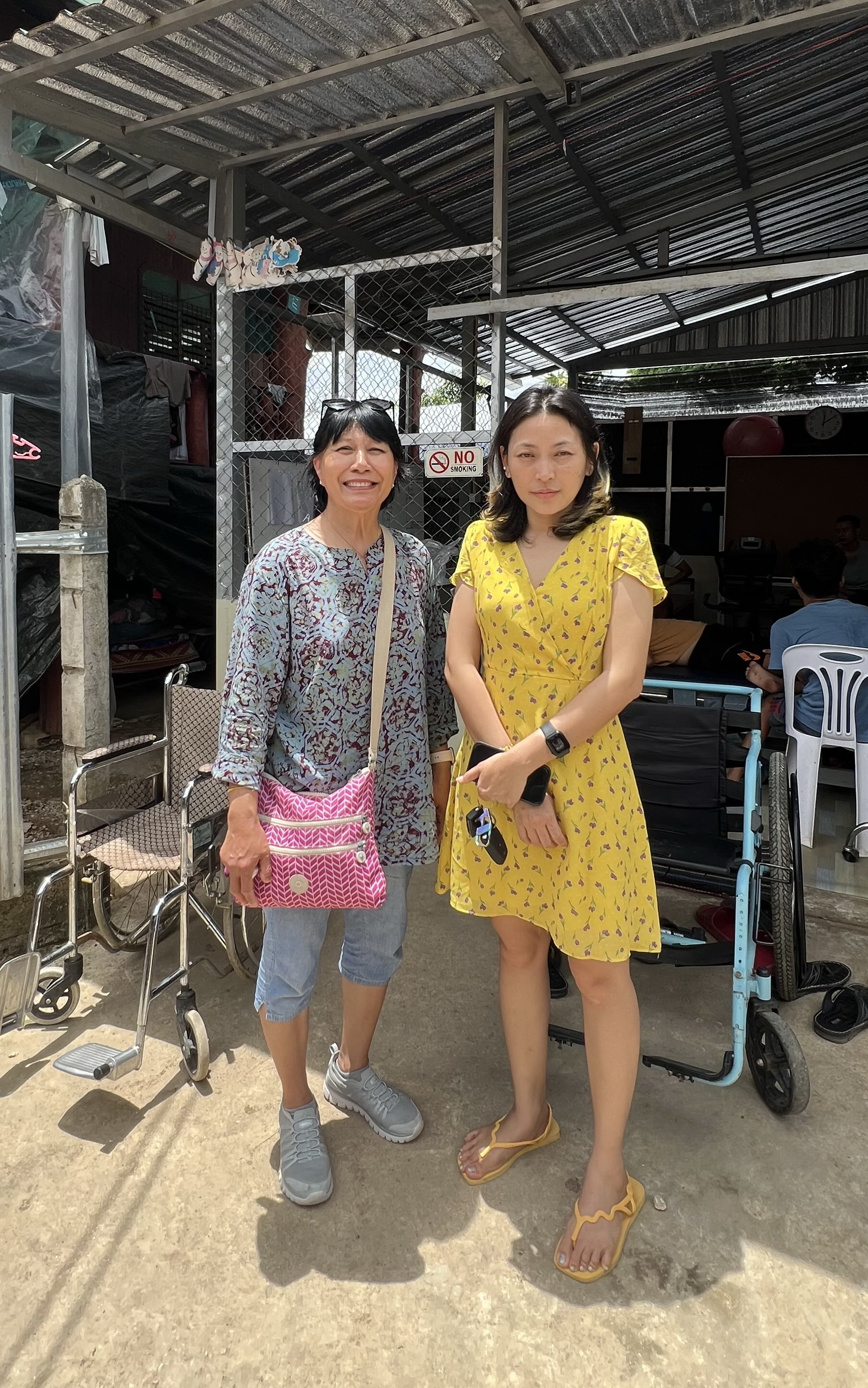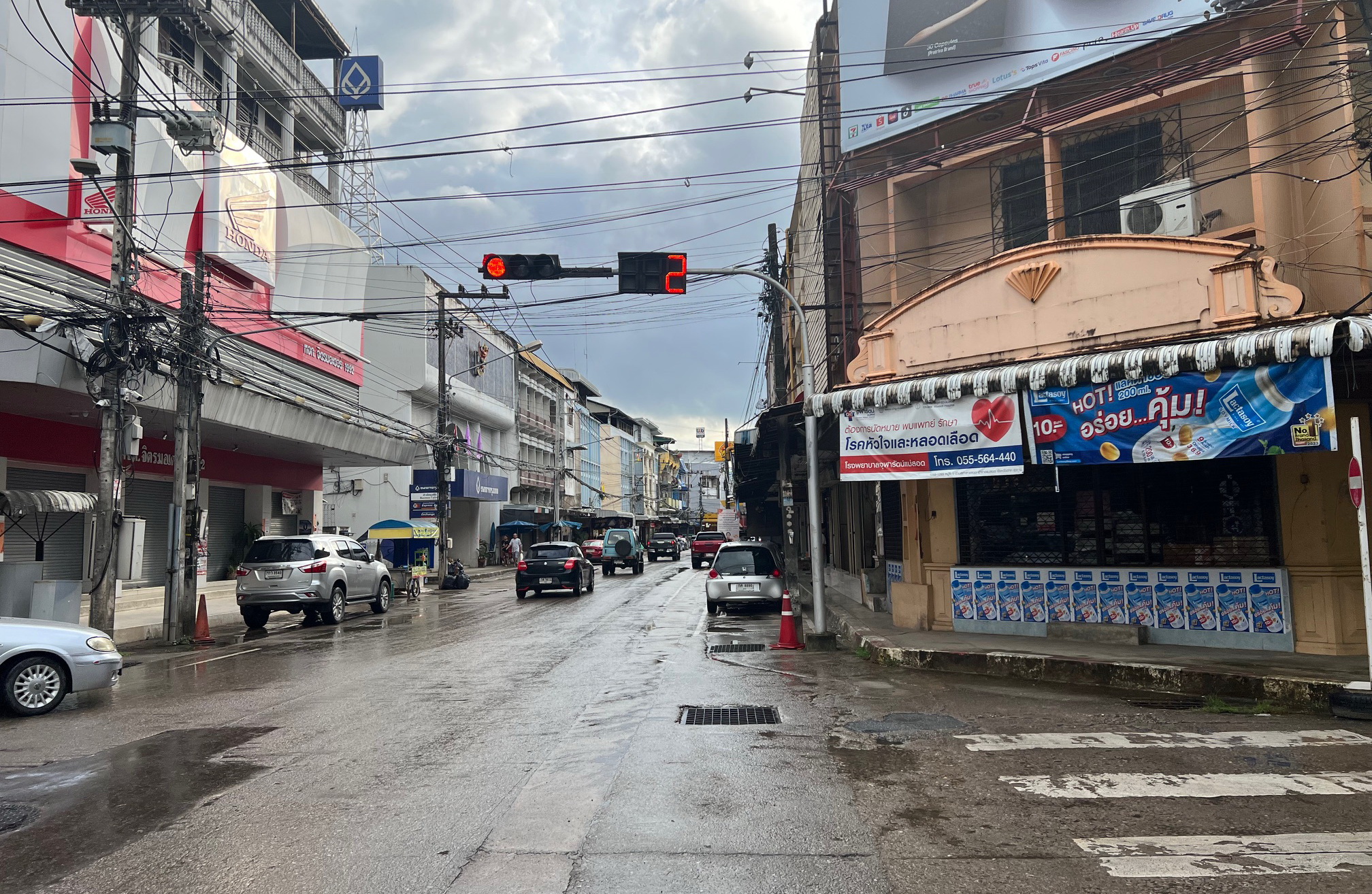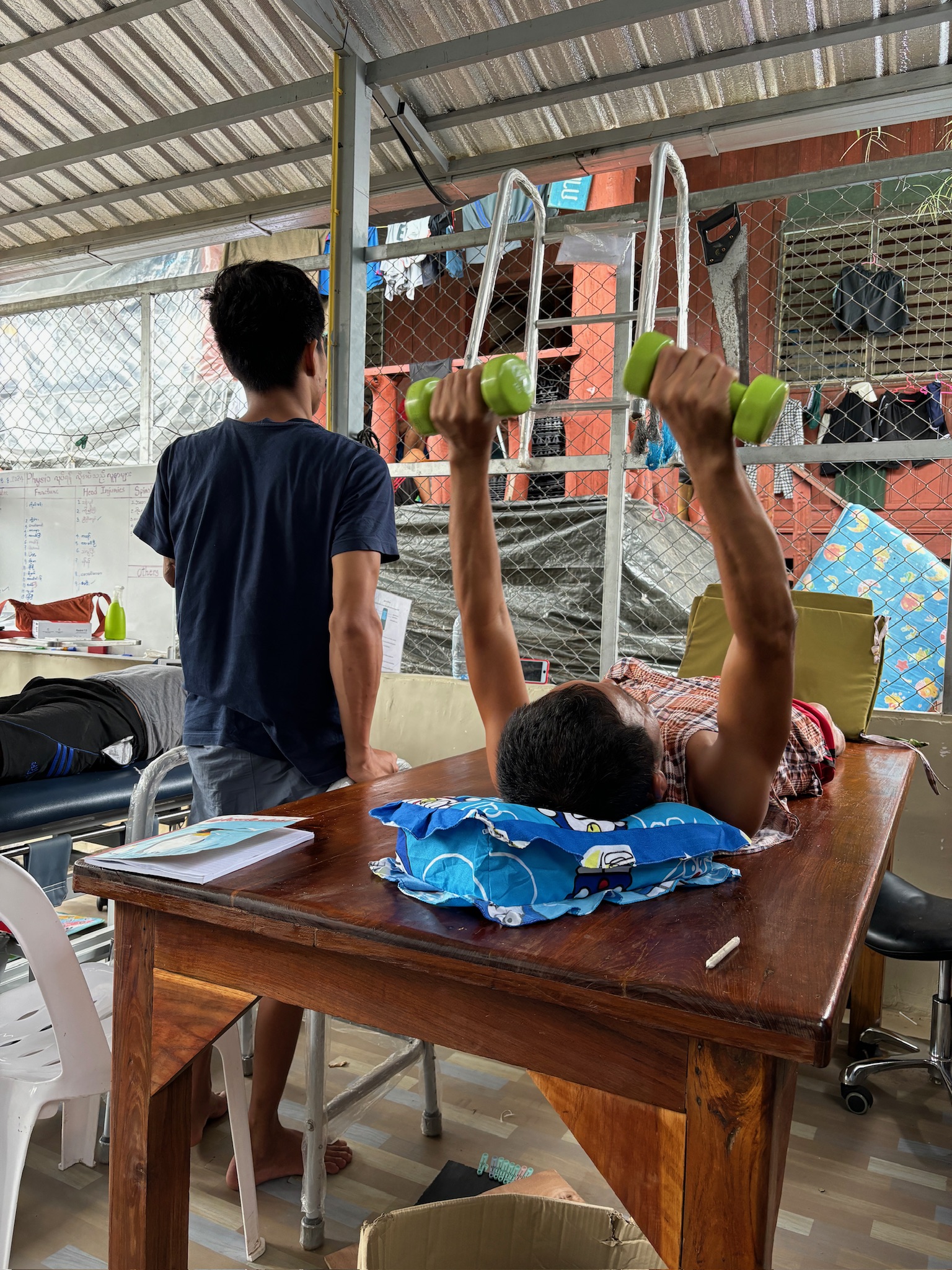MAE SOT, THAILAND—It’s 8 p.m. in Mae Sot, on the border between Thailand and Myanmar, but sunlight still streaks through the humid air. Ah Naw’s special phone buzzes with a message: ETA midnight @ rendezvous point three. One civilian, 45-year-old male; One from the PDF, 22-yr-old male. The next message details the injuries that they sustained and the first aid they were able to receive from jungle medics. Both appear to have been heavily wounded by bombs dropped by Myanmar air force jets.
Ah Naw springs into action, as she has done countless times before. The frequency of these messages correlates directly with the intensity of clashes between Myanmar’s military junta, officially called the State Administration Council (SAC), and ethnic Karen forces: the Karen National Union (KNU), the Karen National Liberation Army (KNLA), and People’s Defense Force (PDF) troops under the KNLA’s guidance. Usually, the messages arrive two or three times per month.
Ah Naw speaks into her phone. “Hey Achara, it’s me,” she says. “Sorry to call so late, but I have a delivery. I’ll be at the hospital with my patients around 1 a.m. I’ll keep you posted.”
Ah Naw continues to relay what she knows about the two incoming patients as she signals her crew to prepare. Mae Sot is a town in Thailand’s Tak district, surrounded by mountains and dense forests. It borders Myanmar’s Karen State, home to the Karen people, many of whom live in small agricultural villages. While the Thai side of the border is lush with trees and greenery, Myanmar’s land has been stripped bare by illegal and unregulated logging.
Several rendezvous points are used depending on where the wounded originated on the Myanmar side. “Point three,” the one tonight, is about 16 kilometers from Mae Sot, deep in the jungle. Though the drive itself only takes 20 minutes, it usually takes about an hour to get from the pick-up spot to the emergency room at Mae Sot General Hospital, or MGH. It is a well-concealed spot near the Moei River, which forms the border between the two countries, at an easy crossing, only thirty feet wide and three feet deep – except during the monsoon season when flash floods can strike without warning.
Ah Naw and her team must make sure all military insignia, dog tags, and uniforms, if any, are removed from the patients. She is only permitted to bring noncombatants to the hospital. Still, she counts her blessings: a call to a Thai liaison like Achara wasn’t possible two years ago, when Ah Naw first started this type of work. Previously, she had to bring patients to the emergency room without notice, creating chaos and straining the hospital’s resources. Eventually, Thai hospital administrators realized the situation could be handled better with forewarning and assigned a liaison to work with Ah Naw.
Earlier that day, Ah Naw had been at MGH attending a care conference with hospital providers to discuss patients ready for discharge from the surgical unit, but still needing in-patient nursing, rehabilitation, and wound care. The Sunshine Care Center (SCC), which she founded two years ago, is the only facility in the Mae Sot area that can provide such care for free to those patients.
Myanmar’s Displaced
Ah Naw isn’t her real name. It just means “Big Sister” in the Karen language, a title she has earned through her tireless efforts. Currently in her late 30s, Ah Naw was a successful small businesswoman and mother of three in Myawaddy, a bustling border city across the Moei River from Mae Sot in Karen State. But when the Myanmar military staged a coup in February 2021, war arrived on her doorstep.

Ah Naw, in yellow dress, receives a well-wisher at the Sunshine Care Center (SCC) in Mae Sot, Thailand. (Photo by Hannah Oo)
The KNU and its armed wing, the KNLA, have been fighting against successive Myanmar Army regimes since the late 1940s, seeking greater autonomy in Karen State. Their bases are dotted in the jungles along the Thai-Myanmar border. After the coup, as peaceful unarmed protestors were ruthlessly gunned down in the cities, many civilians from urban centers fled to KNLA camps, seeking to be trained and armed to fight alongside the KNLA against the Myanmar army. These groups have since structured themselves into PDFs. In response to the growing armed resistance to its rule, the Myanmar Army has taken its violence to the skies, bombing towns and villages with little regard for civilian casualties. Entire villages in Karen State have been flattened or burned down by airstrikes and people, including Ah Naw’s family, have fled across the border to Thailand.
Ah Naw has a college education and previously worked at the local office of the United Nations High Commissioner for Refugees. She speaks Burmese, Karen, Thai, and English. She also had business contacts in Mae Sot and was acquainted with local KNU leaders, allowing her to live in a private residence instead of a typical refugee shelter upon arriving in Mae Sot. But soon, she began witnessing the despair of the war-wounded in the Thai border town.
The war has left few unscathed. Combatants on both sides have been wounded and many civilians caught in the crossfire. The KNLA has medics and basic jungle hospitals that can care for wounded fighters, but they often cannot extend resources to civilians and PDF forces. As a last resort, the wounded are taken to Thailand and left at the doors of border hospitals like MGH. While hospitals admit and care for life-threatening injuries, these patients are left helpless when it comes time for discharge, when painful nursing and recovery await. Local villagers often sneak back into Myanmar to reunite with their relatives who care for them. However, most wounded PDF fighters come from faraway urban centers in Myanmar and have no local connections. The fledgling parallel or shadow government of Myanmar’s democratic forces, the National Unity Government (NUG), does its best to procure funds for these individuals, but it is rarely enough.
At the Beginning
Ah Naw started by bringing a few patients into her home. But soon, the numbers had increased to the point where she could no longer accommodate them. She decided to rent a house for these patients and hired helpers to care for them. She sought private donors to support her activities. At the same time, some non-governmental organizations (NGOs), Thai health authorities, and local social services departments began recognizing these needs. They also found that there was no one more suited than Ah Naw to lead the task. Without the services provided by the SCC, the hospital wouldn’t be able to discharge patients, straining its resources and negatively impacting its average length of stay metrics. The hospital started helping her secure some resources to care for patients after their discharge.
Still, Ah Naw faced many challenges. She is not a Thai national, and cannot operate a skilled nursing or rehabilitation facility without an official license. Instead, SCC has to operate as a boarding house where volunteers assist the disabled. Funding is a constant struggle. It’s hard to find aides willing to work with the most seriously wounded patients who cannot feed themselves or manage personal hygiene. Not being a registered NGO, SCC cannot seek formal grants from big international donors such as USAID, which comes with onerous bureaucratic regulations. Over the past two years, the average number of permanent residents at the facility has grown to about 40 people. Ah Naw named it the “Sunshine Care Center,” symbolizing hope and better, brighter days for its residents.
Achara is a 46-year-old Thai social worker who has lived in Mae Sot all her life. The constant influx of refugees from Myanmar is nothing new to her, but the wave of war wounded in the aftermath of the coup was overwhelming. Two years ago, she was officially assigned to be the liaison for all the wounded arriving from Myanmar.
Achara considers herself a close friend of Ah Naw. “Ah Naw and I know that we cannot provide the best possible care for these patients due to all the constraints, but that doesn’t mean we can’t try,” she says. “And the people we care for are incredibly resilient. It’s amazing how many of them get back on their feet and return to rejoin their comrades. But we also know that some may never be normal again. We have to try our best to help them stay strong.”
On the Medical Frontlines
Kyaw Gyi, 25, wakes at 5 a.m. in the crowded barracks he shares with 20 other residents. Each person has a single suitcase, which they store under their bed. Space at SCC is tight. The bathrooms and toilets are communal. Kyaw Gyi puts on his prosthetic leg and heads to the large tent that serves as a makeshift kitchen and dining hall. He is part of a team of four responsible for preparing daily meals for the 60-odd residents and staff. The center also has teams dedicated to medical care, physical therapy, and cleaning, all staffed by former patients who now volunteer. All have been injured in Myanmar’s conflict and are too disabled to return to the front lines. Those with some medical experience help with physical therapy, wound care, and personal hygiene for the bedbound.

A street in Mae Sot, a town on Thailand’s border with Myanmar. (Hannah Oo)
Kyaw Gyi is originally from Pyay, a city in Myanmar’s heartland about 400 kilometers from the Thailand-Myanmar Border. Like many youth who came to the KNLA camps, he dreamed of becoming a revolutionary PDF soldier and fighting against the Myanmar army. He was seriously wounded in the battle of Lay Kay Kaw in late 2021 and was transported to MGH, where he underwent an above-knee amputation. After being discharged from the hospital, he was cared for at SCC until his wounds healed.
With his injuries, Kyaw Gyi was no longer fit to return to the front lines, and he had nowhere else to go. Returning to his hometown would have been incredibly unsafe, as he would have to pass through hundreds of kilometers of junta-controlled territory. He decided to stay at SCC and help care for the residents. Kyaw Gyi considers himself lucky. Some individuals at the center have sustained significant head or spinal injuries leaving them permanently in need of intensive assistance.
Kyaw Gyi works alongside three others in the kitchen team. Yan Naing, like Kyaw Gyi, is an amputee. Ko Myo, who has undergone multiple surgeries due to shrapnel wounds and orthopedic procedures, suffers from a permanent limp and requires crutches to walk. He is also missing half of his lower jaw and one of his eyes. The youngest member of the team is Doh Htoo, a 17-year-old Karen boy who lost his entire family to a bombing by Myanmar Air Force planes. He is the sole survivor, having endured multiple injuries, and now has no desire to return to his former village. A volunteer doctor who visits the SCC every second week has diagnosed Doh Htoo with PTSD.
Kyaw Gyi approaches his new role as chef with dedication. The job demands a great deal of creativity and resourcefulness, given the limited budget and the need to make do with available resources. The work keeps him busy, making time pass quickly. “It’s not good to sit idly and dwell on the past or on our injuries,” he says. “It’s good to be busy.”
A Day in the Life of a SCC Resident
In addition to the kitchen tent, the SCC compound has two other buildings. One is a two-story structure that has been converted into sleeping quarters. The other is a one-story building that has been transformed into a rudimentary gym, where physical therapy (PT) sessions are held. A small room in this area serves as a classroom. The rest of the space is crammed with various physical therapy machines, most of them second-hand donations from benefactors. Since there are more patients than available equipment, the PT team creates a schedule to spread out appointments throughout the day.

Residents of the SCC engage in physical therapy at the center’s makeshift gymnasium. (Photo by Hannah Oo)
Generally, most physical tasks are finished by the afternoon. That’s when “classes” begin. Ah Naw works to bring in different instructors to teach various trades to SCC residents. Recently, she brought in a baker who taught them how to make Western-style foods such as cakes, bread, biscuits, cookies, and pies. Previously, someone came to teach the residents sewing. She has also arranged for an instructor to come daily and teach Thai, English, and basic computer skills. Ah Naw’s ultimate vision is to offer a variety of vocational training at the SCC so that most residents can eventually earn a living and become self-sufficient.
“I want to be a chef. I want to own and run a restaurant in my hometown one day,” Kyaw Gyi says. “When the military dictatorship that has oppressed our country for the past seventy years is removed, and Myanmar finally achieves democracy, I will go home. I don’t want to stay in Thailand forever or resettle in a Western country. I want to go home.”
Sunrise in Mae Sot
It’s 6 a.m. Ah Naw walks over to the kitchen and is greeted with a joke and a smile from Kyaw Gyi. Laughing she asks, “What’s for breakfast? Is it ready yet? I didn’t get back from MGH until 4 a.m. last night. And after a few hours of sleep, I’ve remembered to be hungry!”
Kyaw Gyi replies, “Give me fifteen, and I’ll bring it to your office. By the way, how did the two from last night do?”
“I think they’re going to make it,” she replies. “I think we’ll be welcoming two new residents to the family. We better get cooking!”
Ah Naw also shares with Kyaw Gyi and the kitchen team the information that a donor is considering purchasing a plot of land for SCC. If this goes through, she plans to build a new facility with much-needed extra space for the residents, offering more spacious accommodations and improved sanitary facilities. Kyaw Gyi is eager to move; at the current site, the SCC workers are crammed in like sardines.
“This facility provides hope for so many wounded and displaced people,” Ah Naw says. “I want to build a larger facility with modern equipment and resources to provide care for our patients. I want to offer them a place where they can regain both their strength and their dignity, a place where they can thrive and be ready to return to Myanmar one day.”
For now, Ah Naw focuses on immediate needs.
“There are moments when the weight of it all feels overwhelming,” she admits, “but I remind myself why I do this. These people have sacrificed so much for Myanmar, even parts of their own bodies. Most only focus on the battles that make the headlines, but few think about the wounded warriors who paid the price. We owe them more than we can express, both now and in the future, when Myanmar achieves democracy and begins to rebuild. When I see the faces of those we help, I know I can’t give up.”

































